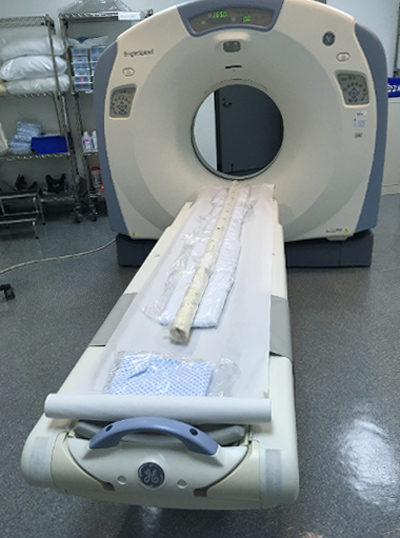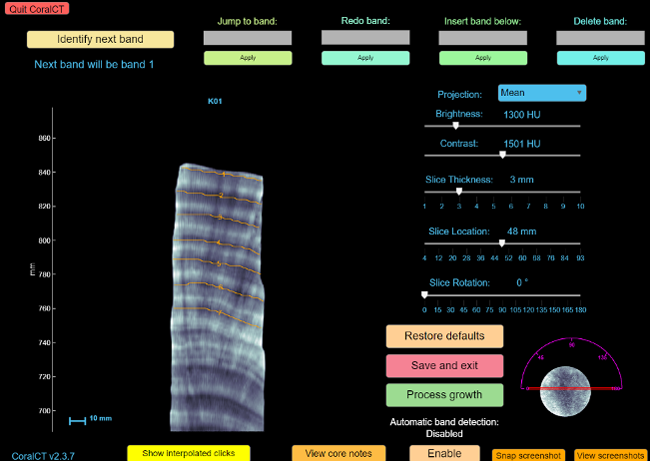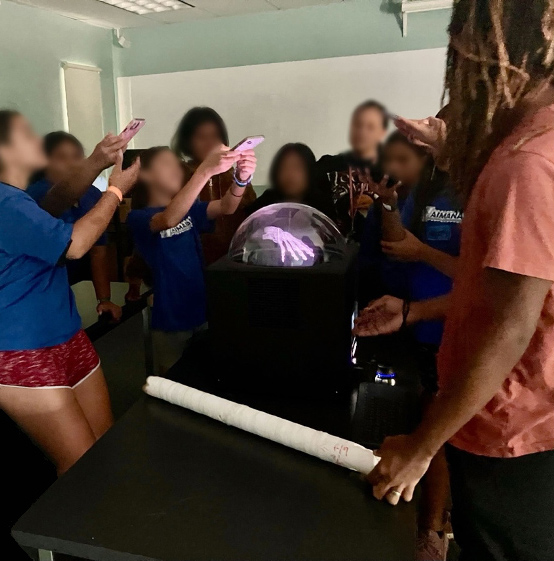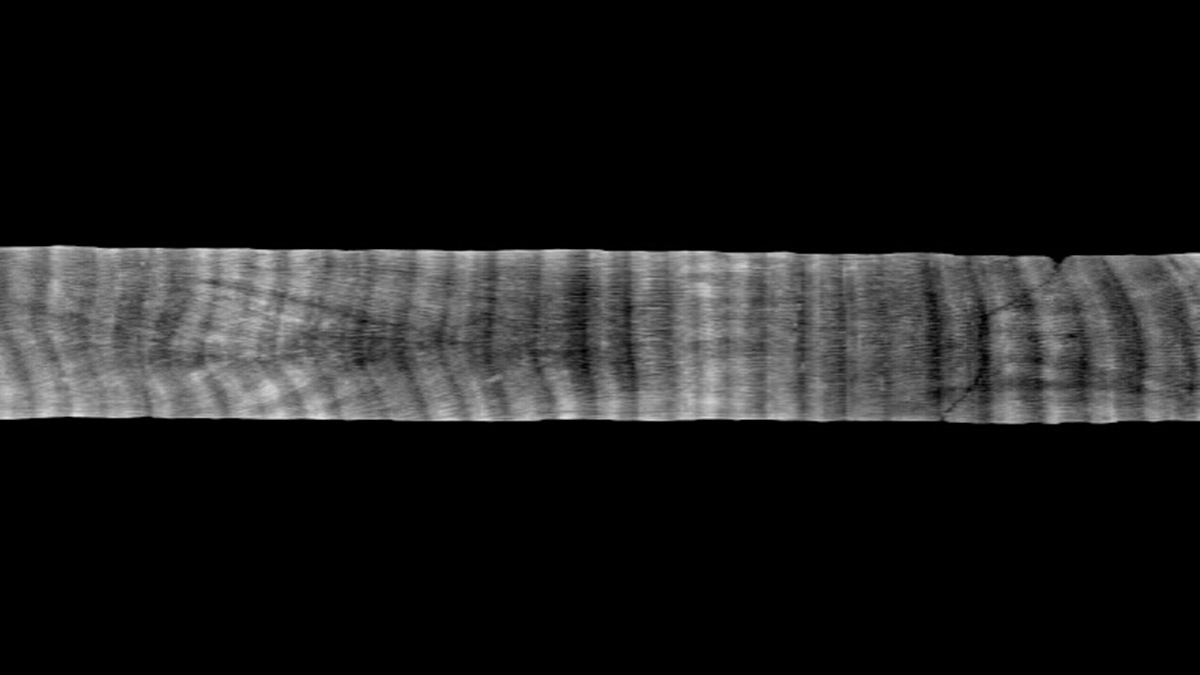A translation of this article was made possible by a partnership with Planeteando. Una traducción de este artículo fue posible gracias a una asociación con Planeteando.
Coral reefs are vital ecosystems supporting marine life, ecotourism, and coastal protection. They also hold something valuable under their surface: records of the ocean’s past. Beneath the living outer layer of massive corals are dense, rocklike skeletal structures containing annual bands, similar to tree rings. Scientists can study the conditions at the time these bands formed by drilling, retrieving, and analyzing cores, some of which represent centuries of coral growth.

Since the 1970s, studies of coral cores to determine past growth patterns, a field known as coral sclerochronology, have produced notable scientific discoveries. Knutson et al. [1972] found that annual bands comprise alternating high- and low-density bands that reflect seasonal growth patterns. Hudson [1981] found that typically, high-density bands form during slower winter growth and low-density bands form during faster summer growth and that long-term coral growth variations are influenced by water quality and the effects of coastal development. Some cores also contain high-density “stress bands” formed because of coral bleaching events or other environmental challenges [Lough, 2008]. Together, this banding provides insights into coral growth history, enabling scientists to construct reliable age models of past oceanic and climatic conditions.
Today, methods used to investigate coral cores have advanced considerably. Alongside other methods such as stable isotope and elemental ratio analyses, computed tomography (CT) scanning plays a major role in yielding data that help to reveal coral growth parameters. Scientists can use 2D X-ray and 3D CT scanning to examine the internal structure of coral cores, including their annual density bands [Knutson et al., 1972; Hudson, 1981; Lough, 2008; DeCarlo et al., 2025]. In some cases, such analysis even involves a scientist visiting a local hospital to use its CT machine—an unexpected patient for the radiology technician.


However, there has been no systematic archiving of coral core imagery data, partly because of the lack of a suitable repository. This gap presents risks of losing valuable images and prevents streamlined, transparent sharing of scientific interpretations from these images. Therefore, a centralized, virtual, open-access repository of coral core imagery is crucial for fostering transparent science and preserving these resources for future research.
An App for Organizing an Archive
The CoralCT application was developed to consolidate and organize coral core scans in a virtual repository that enables digital archiving and image analysis [DeCarlo et al., 2025]. The repository currently contains scans of more than 1,000 cores collected from a wide range of coral reef regions, including the Great Barrier Reef, the Caribbean, and the Red Sea. These core scans have been contributed by individuals and agencies, including the U.S. Geological Survey (USGS) and NOAA.
Coral researchers upload X-ray or CT scans to CoralCT and, when they are ready, can make their data publicly available to anyone with a computer and internet connection. This approach to transparency fosters collaborations among coral core researchers, who can view the app’s core directory and see who else has collected cores from their areas of interest. It also helps avoid unnecessary duplication of research efforts, which is especially important given the need to reduce sampling impacts on corals, many of which are endangered species.
Using the application’s analytical tools, observers can map annual density bands in coral cores to extract data on growth rates and skeletal density. As in tree ring studies, this sort of analysis offers insights into past environmental conditions because coral growth can respond sensitively to climate variability.
For example, Barkley et al. [2018] used CoralCT to visualize high-density stress bands and reconstruct the history of coral bleaching over 6 decades on a remote reef in the equatorial Pacific Ocean where monitoring data were sparse. Rodgers et al. [2021] measured annual growth rates in CoralCT to track the recovery of corals off Kaua‘i, Hawaii, in the 15 years after a damaging flood event. More recently, DeCarlo et al. [2024] leveraged the breadth of cores in CoralCT to reconstruct coral growth trends over recent decades to centuries across thousands of kilometers of the Indo-Pacific.
Rescuing Old Records and Gathering New Ones
Archiving valuable data that might otherwise be lost is a foundational purpose of CoralCT. A standout example of how it’s serving this purpose involves the rescue and digitization of X-ray images of more than 20 cores collected across the Pacific Ocean between the 1980s and early 2000s. The X-ray films, previously stored by a retiring scientist, are now archived and available for analysis on CoralCT.
Older collections like these can provide valuable insights into coral growth before environmental disturbances, such as mass bleaching from heat stress, began to affect them.
In a similar effort, USGS recently CT scanned coral cores dating back to the late 1960s, some of the earliest cores ever collected [Hudson et al., 1976]. These scans are being added to the repository so they can be reanalyzed by researchers now and into the future. Older collections like these can provide valuable insights into coral growth before environmental disturbances, such as mass bleaching from heat stress, began to affect them.
Alongside these historical contributions, CoralCT’s repository continues to grow with the addition of new data. One such recent contribution includes scans of reef cores collected from offshore Hawai‘i in 2023 during the International Ocean Discovery Program’s Expedition 389. Reef cores differ from coral cores in composition and structure but are also critical for understanding ocean history and environmental change. During Expedition 389, cores were collected from drowned reefs that once grew near the ocean surface but stopped calcifying as they were submerged in deeper water. These reef cores contain fragmented coral, coralline algae, microbialites, and other reef-building materials whose compositions enable scientists to look millennia into the past and uncover valuable records of sea level and climate change.
Repeatable Analyses, Verifiable Results
When raw, unprocessed coral core images are not archived, the value of growth measurements and other analyses is limited because other scientists cannot readily and independently verify them. This is problematic because science fundamentally relies on the ability to repeat experiments and verify results, especially considering individual researchers can introduce subjectivity and potential biases into even highly systematic and rigorous interpretations of data. As datasets grow larger, more intricate, and more numerous, maintaining transparency is increasingly important but also increasingly difficult.

CoralCT addresses these challenges by ensuring that all information and context about a core is fully documented, accessible, and downloadable. This information includes essential metadata such as the core’s origin, ownership details, collection date, depth, and species identifications. Most important, CoralCT archives the user-defined maps of annual banding used to derive growth rate data [DeCarlo et al., 2025], ensuring that these data and interpretations are fully reproducible and open to verification by others.
This transparency is also shared among observers within the application. When a user is mapping the bands of a core, they can add notes and screenshots that other users can view when they’re analyzing that core. Furthermore, when a user finishes mapping the bands of a core and processes the data, this information is saved and made downloadable for other scientists to view. This ability enables scientists to conduct multiobserver studies, which can reduce potential biases introduced by individual observation.
A challenge encountered in our efforts to broaden CoralCT has been the hesitancy of some researchers and programs to share data.
Despite these advantages, a challenge encountered in our efforts to broaden CoralCT has been the hesitancy of some researchers and programs to share data because of concerns about intellectual property infringements and the “scooping” of prepublication data. This hesitancy, which is understandable considering the lack of transparency and protections for data owners in prior data management practices, can unfortunately limit scientific advancements and collaborations that might help address climate change, coral reef degradation, and other complex challenges.
To address these concerns, CoralCT offers privacy controls to core owners that they can use to restrict access to their scans and the derived output data. These controls are particularly useful when cores are part of ongoing research that has not yet been published or are subject to a postcruise moratorium, ensuring that sensitive data remain protected until the research is ready to be shared. In addition, each core is tagged with a data owner, acknowledgments, and relevant citations.
Advancing Accessibility and Collaboration
CoralCT also represents a path to making science more inclusive and accessible. The application is designed with an easy-to-use interface and includes resources such as video tutorials and a step-by-step user guide to help introduce its features to a wide audience. K–12 lesson plans that guide students through mapping coral core bands in the app were also recently created, offering approachable ways to explore marine science.


The app’s educational potential was demonstrated during recent outreach events. Using virtual reality technology, middle school students in New Orleans viewed 3D coral core scans from CoralCT and practiced identifying annual density bands. At a similar event, sixth grade students in Hawaii interacted with 3D holographic coral cores, learning how scientists retrieve and study them to understand growth patterns over time. The positive experiences of students and teachers during these events demonstrated how CoralCT provides an opportunity to engage hands-on with real scientific data.
Integration of AI could also, importantly, make it easier for all users to contribute to coral core analysis, regardless of their academic background or field experience.
Looking forward, there is potential to integrate artificial intelligence (AI) into CoralCT for automated identification of coral banding patterns. If an AI system were trained on existing human interpretations, it could automatically suggest band markings that users could review and verify. This advancement offers the potential for more accurate and efficient coral core analyses while maintaining human oversight. Integration of AI could also, importantly, make it easier for all users to contribute to coral core analysis, regardless of their academic background or field experience. Each new contribution or analysis of a core enhances the CoralCT database and extends our knowledge of coral reefs and past ocean conditions.
Coral sclerochronology is vital for understanding environmental changes in coral reef ecosystems and the impacts these changes have wrought. Through this research, we gain insights into the ocean’s past and advance our understanding of coral reefs today. As threats to reefs intensify, large open-access datasets are increasingly essential for monitoring reef health and predicting future impacts.
CoralCT thus plays an important role in preserving valuable records of coral growth and environmental history while promoting collaborative, accessible, and transparent data sharing. In making coral reef science available to researchers and the public alike, it is connecting data, ideas, and people to address critical questions about our changing world.
Acknowledgments
CoralCT was developed with support from National Science Foundation award OCE-2444864. Any use of trade, firm, or product names is for descriptive purposes only and does not imply endorsement by the U.S. government. We thank the IODP 389 Expedition Science Party, ECORD Science Operator (ESO) support staff, benthic drilling team, MMA surveyors, and the captain and crew of the MMA Valour. International Ocean Discovery Program (IODP) Expedition 389 was supported by funding from the various national funding agencies of the participating IODP countries. We also thank all data contributors to date, including Giulia Braz, Jessica Carilli, Leticia Cavole, Ben Chomitz, Travis Courtney, Ian Enochs, Thomas Felis, Ke Lin, Malcolm McCulloch, Haojia Ren, Riccardo Rodolfo-Metalpa, Natan Pereira, and the U.S. Geological Survey Coastal and Marine Hazards Resources Program.
References
Barkley, H. C., et al. (2018), Repeat bleaching of a central Pacific coral reef over the past six decades (1960–2016), Commun. Biol., 1, 177, https://doi.org/10.1038/s42003-018-0183-7.
DeCarlo, T. M., et al. (2024), Calcification trends in long-lived corals across the Indo-Pacific during the industrial era, Commun. Earth Environ., 5, 756, https://doi.org/10.1038/s43247-024-01904-8.
DeCarlo, T. M., et al. (2025), CoralCT: A platform for transparent and collaborative analyses of growth parameters in coral skeletal cores, Limnol. Oceanogr. Methods, 23(2), 97–116, https://doi.org/10.1002/lom3.10661.
Hudson, J. H. (1981), Growth rates in Montastraea annularis: A record of environmental change in Key Largo Coral Reef Marine Sanctuary, Florida, Bull. Mar. Sci., 31(2), 444–459, www.ingentaconnect.com/content/umrsmas/bullmar/1981/00000031/00000002/art00014.
Hudson, J. H., et al. (1976), Sclerochronology: A tool for interpreting past environments, Geology, 4(6), 361–364, https://doi.org/10.1130/0091-7613(1976)4<361:SATFIP>2.0.CO;2.
Knutson, D. W., et al. (1972), Coral chronometers: Seasonal growth bands in reef corals, Science, 177(4045), 270–272, https://doi.org/10.1126/science.177.4045.270.
Lough, J. M. (2008), Coral calcification from skeletal records revisited, Mar. Ecol. Prog. Ser., 373, 257–264, https://doi.org/10.3354/meps07398.
Rodgers, K. S., et al. (2021), Rebounds, regresses, and recovery: A 15-year study of the coral reef community at Pila‘a, Kaua‘i after decades of natural and anthropogenic stress events, Mar. Pollut. Bull., 171, 112306, https://doi.org/10.1016/j.marpolbul.2021.112306.
Author Information
Avi Strange and Oliwia Jasnos, Tulane University, New Orleans, La.; Lauren T. Toth, St. Petersburg Coastal and Marine Science Center, U.S. Geological Survey, Fla.; Nancy G. Prouty, Pacific Coastal and Marine Science Center, U.S. Geological Survey, Santa Cruz, Calif.; and Thomas M. DeCarlo ([email protected]), Tulane University, New Orleans, La.

